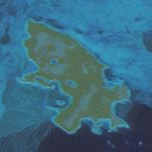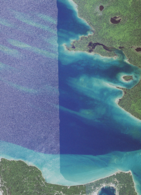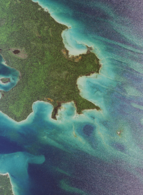Garden Island (Michigan) facts for kids

Taken on March 20, 2022 with Resourcesat-2
|
|
| Geography | |
|---|---|
| Location | Lake Michigan |
| Coordinates | 45°48′N 85°29′W / 45.800°N 85.483°W |
| Area | 7.8 sq mi (20 km2) |
| Highest elevation | 610 ft (186 m) |
| Administration | |
| State | Michigan |
| County | Charlevoix County |
| Township | St. James Township |
| Demographics | |
| Population | Uninhabited |
Garden Island is a special place in northern Lake Michigan. It's part of the Beaver Island group of islands. This island is quite large, about 4,990 acres (20 square kilometers).
Most of Garden Island is owned by the U.S. state of Michigan. The Michigan Department of Natural Resources (DNR) looks after it. It is part of the Beaver Islands State Wildlife Research Area. You can visit the island by private boat.
The Native American name for the island is Minis Gitigaan. This comes from the Ojibwe language. It means "Garden Island." A Native American cemetery on the island is very important. It was added to the National Register of Historic Places in 1978.
Contents
Island History
Garden Island is about five miles (8 kilometers) long. Today, no one lives on the island all year round. But a long time ago, many Anishinaabe people called it home. Some lived there all year, while others stayed during the warmer months.
Early Native American Life
After treaties in 1836 and 1847, more Anishinaabe people from the mainland and Beaver Island owned farms on Garden Island. They grew crops like corn and squash. Other Anishinaabe worked as fishermen.
The Native settlement on the island became smaller in the early 1900s. Many people moved away. Much of the land went back to the state of Michigan. This happened because the islanders were not told clearly about property tax rules. The last person to live on Garden Island, Peter Monatou, passed away in the 1940s.
The "Success" Sawmill
Around 1912 and 1913, a sawmill operated on Garden Island for a short time. Most of the very old trees on the island were cut down then. A small town was built near the mill. It was called "Success," Michigan. Today, it is a true ghost town.
Scouts on Survival '78
In 1978, Garden Island was the setting for a special event. It was called "Scouts on Survival '78." This was a program for 48 Senior Girl Scouts, aged 15 to 18. They came to Michigan State University to learn survival skills.
After two weeks of classes, the girls spent a week practicing at Rose Lake Park. Then, they went to Garden Island for another week. On the island, they were put into groups of eight. Each girl had only a knife, flint and steel, and a space blanket. The girls survived by building shelters, setting traps, fishing with handmade hooks, and finding wild plants to eat.
Island Terrain
Garden Island is surrounded by cool, shallow water. This makes it a great spot for both sport and commercial fishing. The island itself is mostly flat. It has many ponds and wetlands. Garden Island is also known for its rare and endangered plants.
Native American Cemetery
Even though no one lives on Garden Island all year, a Native American cemetery is still used there. It is called the Garden Island Indian Cemetery. More than 3,500 people are buried there. Most of the graves do not have markers.
The cemetery is special because of its "spirit houses." These small structures mark some of the burial sites. A nonprofit group owns the cemetery land. They keep the site safe and open for all Native peoples.
Notable Residents
Gallery







